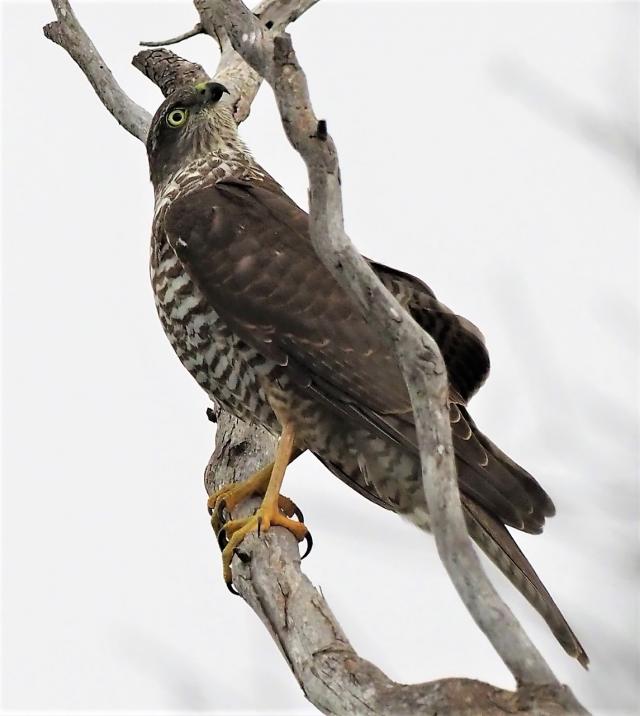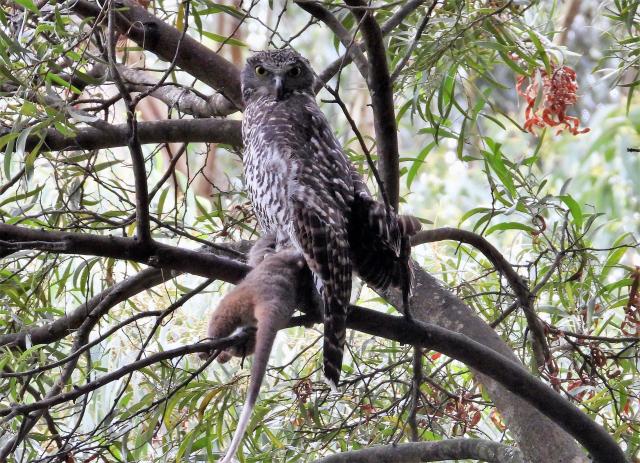I’ve been a bit ‘snowed under’ the past few weeks and have not had many chances to go birdwatching around the Bellarine.
The most exciting observations I have made have been in ‘Sue’s Park’ in my local street, where I heard and saw a female golden whistler, and a pair of spiny-
cheeked honeyeaters.
Fortunately, some wonderful Voice readers have come to my rescue by sending me their observations and photos.
I received an email from Carole, who went on a birdwatching trip to the Otways with the local Bellarine Birdlife Group. She sent me several photos of a juvenile powerful owl that had a possum in its talons.
Carole explained that the owl was staring in disbelief at the oohing and ahhing admirers staring at it from below. When the group returned to the area three hours later the bird was still in the same position and had not had any of its possum lunch.
Powerful owls are the largest of Australia’s owls. Its main item of prey is possums, and they also feast on bats such as flying foxes.
I would have loved to have been on that Bellarine Birdlife outing.
I received an email from Alan. He saw a surprising number of eastern rosellas around Blue Waters Lake, but he found it hard to get a good photo, as the birds were camera shy, and the noisy miners were scaring them off.
He did photograph a grey butcherbird that was not so intimidated by the noisy miners. Alan walked around the Ocean Grove Nature Reserve a few times and came across a collared sparrowhawk that was harassing two yellow-tailed black cockatoos, and a spotted pardalote and a juvenile golden whistler.
Alan also visited the Otways and stayed for four days at Gellibrand and the magnificent Redwood Forest.
He was lucky enough to capture a photo of a male pink robin catching bugs around the creek.
He also saw gang-gang cockatoos around the caravan park, where the park owners told me that someone had recently listed 52 species of birds around the caravan park in a one-week stay.
I received an email from ex-Ocean Grove resident Denis, who has moved to the Bendigo area. He sent a series of wonderful images of a rainbow bee-eater, taken at Lyell Forest, an area which I must explore at some stage.
George Appleby saw a rainbow bee-eater near the Ocean Grove Nature Reserve last year, and they can be seen around the Brisbane Ranges.
Susanne sent me a photo of a leucistic Pacific black duck at Blue Waters Lake, Ocean Grove.
This duck has been around the BWL for a year or two. Its plumage is a lot paler than the usual Pacific black duck. This species of duck is brown but has a black stripe that runs across the face from the bill through the eye.
These ducks are ‘game’ birds and as it’s currently the cruel duck shooting season, maybe this bird was sheltering at BWL from the guns.
Leucism is a condition of reduced pigmentation affecting various animals such as birds, mammals, and reptiles.
It is characterised by an overall pale colour or patches of reduced colouring, caused by a genetic mutation which inhibits melanin and other pigments from being deposited in feathers, hair, or skin.
I received an email from Kevin, who came across lots of Australian white ibises and royal spoonbills beside a roadside dam near the Swan Bay Jetty. There must have been close to 100 of them.
Sometime later, most of them took flight for no apparent reason. They flew over Kevin, still as mixed groups of ibises and royal spoonbills.









